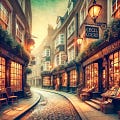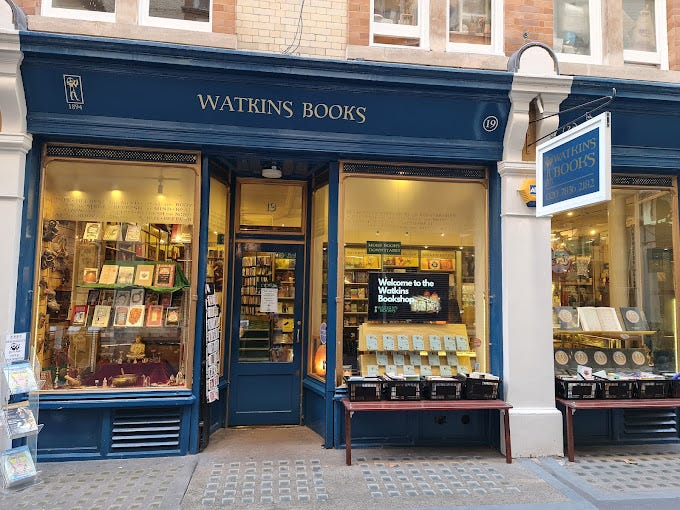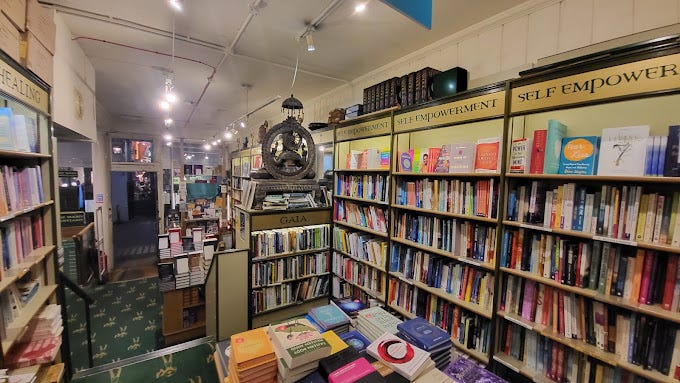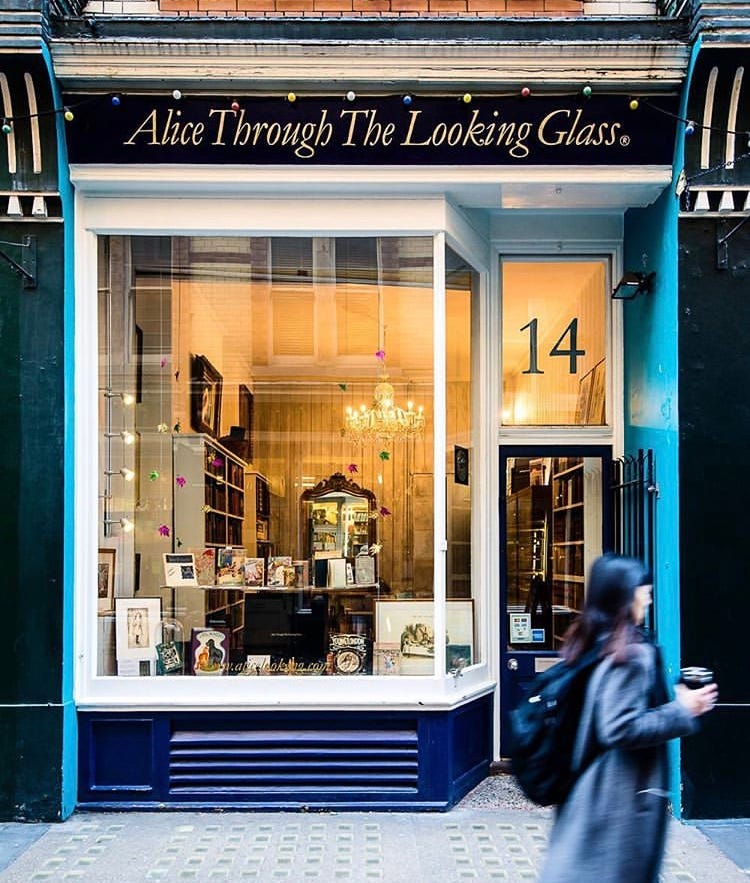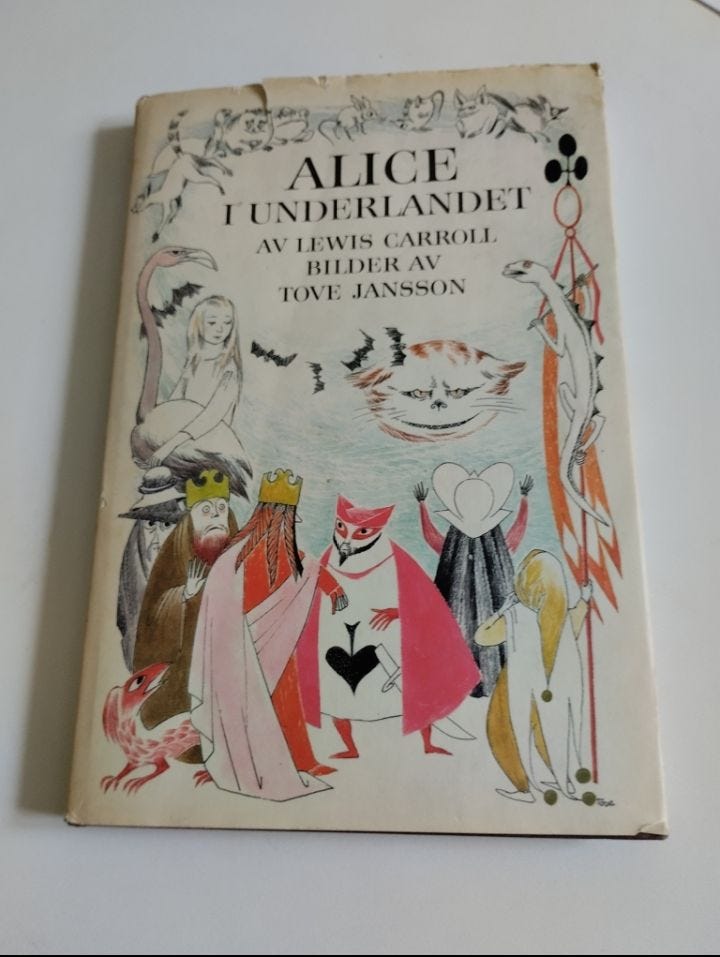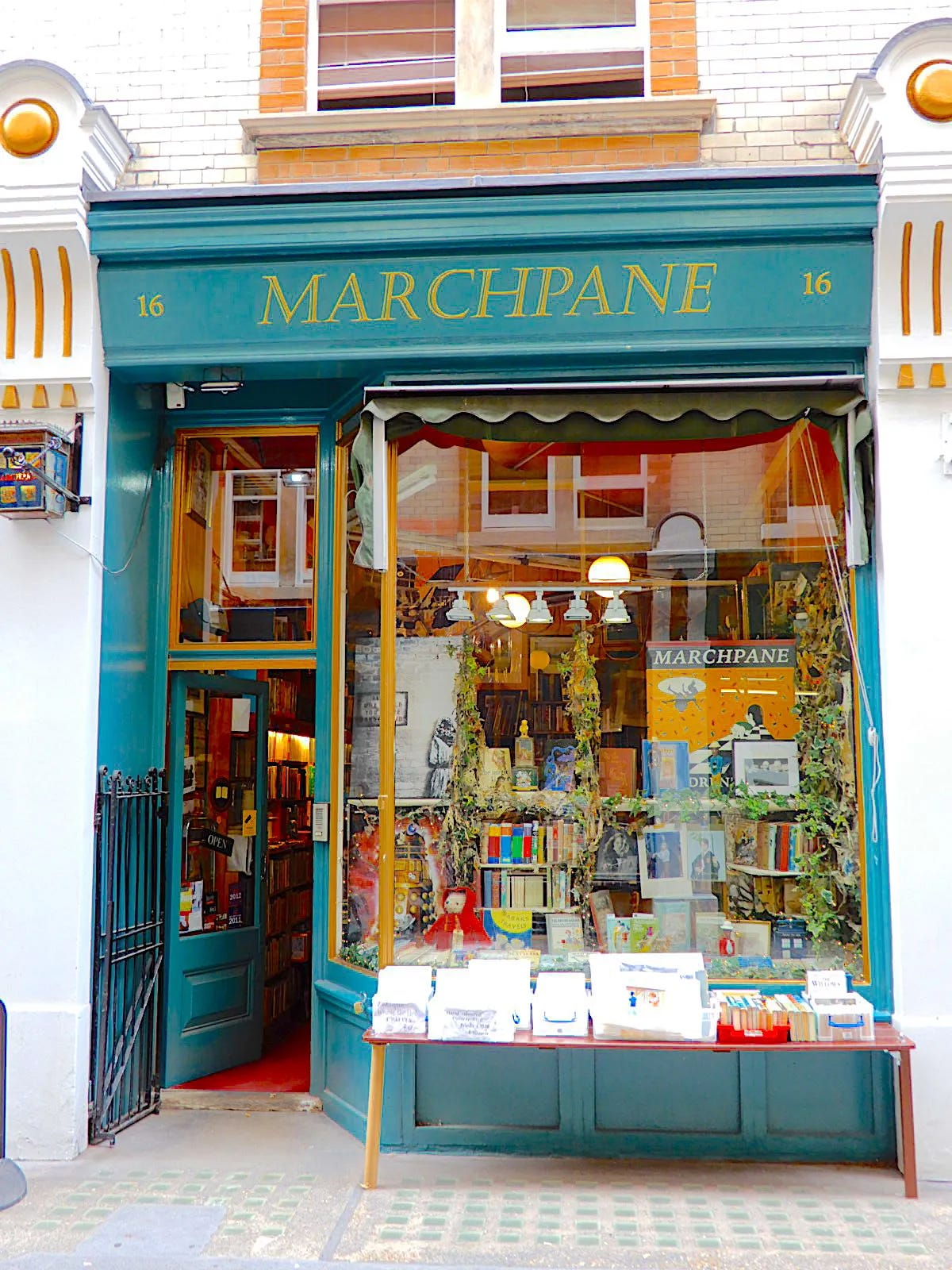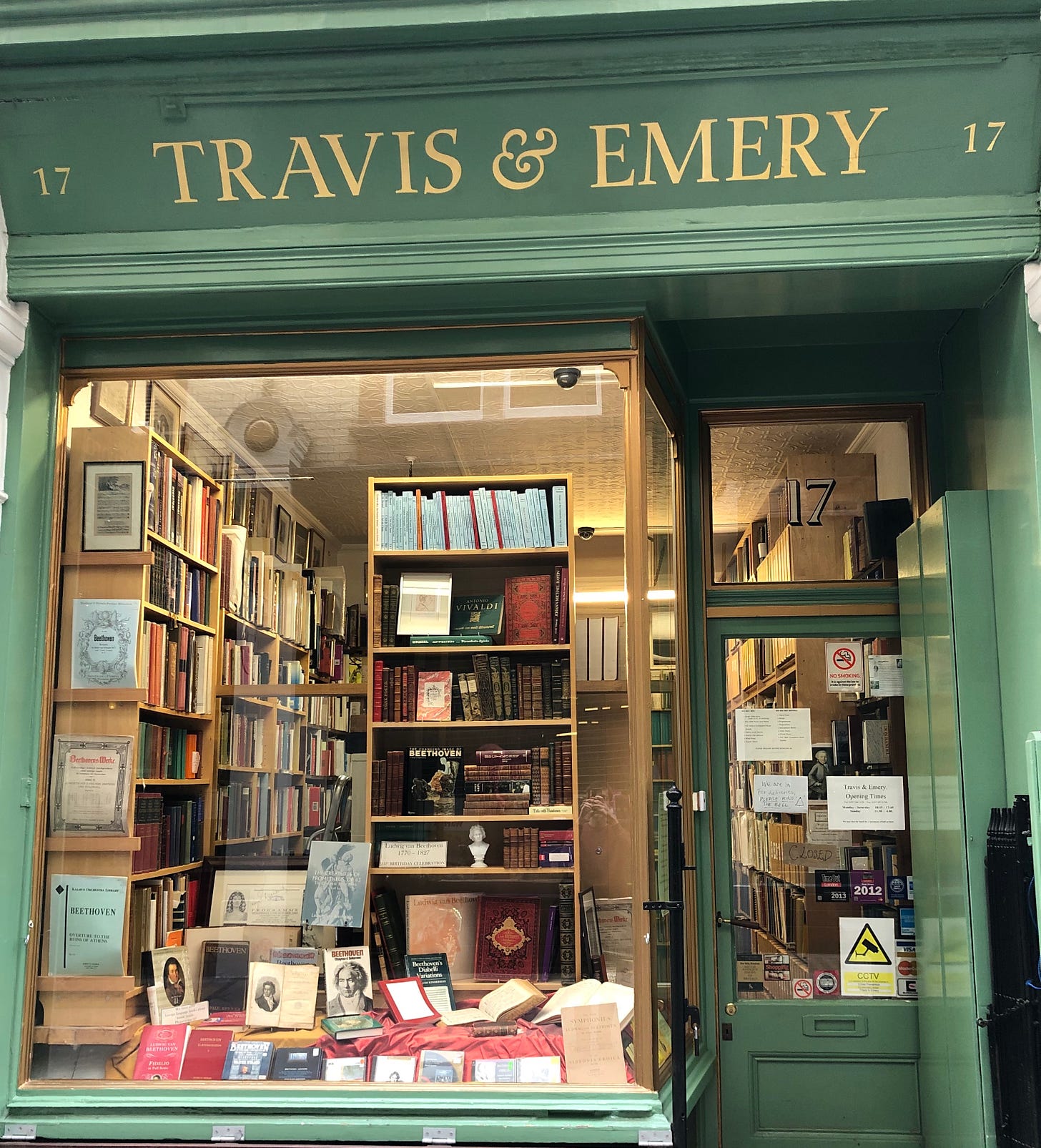Curiouser and curiouser!' cried Alice (she was so much surprised, that for the moment she quite forgot how to speak good English); `now I'm opening out like the largest telescope that ever was! Good-bye, feet!' (for when she looked down at her feet, they seemed to be almost out of sight, they were getting so far off).
Cecil Court in London, close by to Leicester Square Underground station is a pedestrian street with Victorian shop-frontages linking Charing Cross Road and St Martin's Lane. Since the 1930s, it has been known as the new Booksellers' Row, although an earlier "Booksellers' Row" existed at Holywell Street, London, demolished circa 1900.
Booksellers have been a feature of London for centuries. At the time of the introduction of the printing press in the late Fifteenth Century booksellers were based at St Paul’s Cross and were known as Stationers – it is suggested because they operated for stationary carts.
Cecil Court is one of the older thoroughfares in Covent Garden and dates to the end of the 17th century. Earlier maps clearly identify a hedgerow running down the street's course. It was a tradesman's route at its inception.
Cecil Court much later acquired the nickname "Flicker Alley" from the concentration of early film companies in the Court.
Film pioneers such as James Williamson and Cecil Hepworth regarded ‘Flicker Alley’ as the heart of the early British film trade; a young Arthur Ransome honed his writing skills while doing as little work as possible for Ernest Oldmeadow at the Unicorn Press; long-term residents of the flats above Cecil Court include T.S. Eliot and actors such as Ellen Terry and John Gielgud, and patrons of the shops below range from Aleister Crowley to Graham Greene, by way of T.E. Lawrence.
It is now known as home to a number of antiquarian and second-hand independent bookshops, including specialists in modern first editions, collectible children's books, early printing, rare maps and atlases, antique prints, music, and esoterica, as well as art galleries, an antiques shop, shops specialising in antique silver, militaria, numismatics, porcelain, jewellery and art deco.
It is located a few yards from the cinemas of Leicester Square, close to the Coliseum and Royal Opera House, the boutiques of Covent Garden and galleries of Trafalgar Square, and it is only a few minutes’ walk from Parliament in one direction and the Royal Courts in another.
It has been suggested that the street was named after Robert Cecil, 1st Earl of Salisbury, the 1st Earl of Salisbury, an important courtier to Queen Elizabeth I and James I. However, it seems to be one of a number of nearby streets and places that have been named after the land-owning family including Cranbourn Street and The Salisbury pub on St Martin's Lane.
A substantial part of Cecil Court was razed to the ground in 1735, almost certainly arson on the part of a tenant, Mrs. Colloway, who was running a brandy shop/brothel in the street at the time: she purchased kindling, emptied her brandy barrels, over-insured her stock and made certain that she was drinking nearby with friends at the time the fire took hold. However, she was acquitted.
The street rose from the ashes to become the temporary home of an eight-year-old Wolfgang Amadeus Mozart while he was touring Europe in 1764. For almost four months, the Mozart family lodged with barber John Couzin.
Tickets for Mozart's first London concerts were sold from Couzin's shop and, while living there, the young Mozart performed twice for King George III and was tested for his musical ability by Dr. Charles Burney. According to some modern authorities, Mozart composed his first symphony while a resident of Cecil Court.
In September 2011, the Cecil Court Traders' Association installed a plaque commemorating Mozart's relatively brief, but significant, period of residence in the street. The plaque sits at Number 9 Cecil Court, which—contrary to earlier assumptions placing the Mozart lodgings at Number 19 —has been confirmed as the site of John Couzin's barber shop.
It doesn’t take any great leap of imagination to picture Hogarth using Cecil Court as a shortcut between his house in Leicester Square and his Academy in St Martin’s Lane, or Johnson and Boswell hurrying the other way, from Old Slaughter’s Coffee House to a meeting of the Club on Gerrard Street.
The earliest evidence for bookselling in Cecil Court that has emerged so far is Huguenot and Jacobite, with a dash of smut. In 1704 an edition of J.F. Ostervald’s “Catechisme ou instruction dans la Religion Chretienne”, possibly printed in the protestant stronghold of Neuchatel was offered for the London market by Noe’ Bouquet “libraire, a l’enseigne de la Bible dans Cecil Court”. The first Cecil Court bookseller.
In 1717 and 1718 his widow, “la veuve Bouquet” sold at least two pamphlets by the French protestant exile (and minister at the Savoy) Jean-Armand Durbourdieu and an edition of C. Pegorier’s “Maximes sur la Religion Chretienne”.
An advertisement leaf at the back of the fairly innocuous “Bishop Burnet’s Travels through France, Italy and Switzerland” (London, T. Payne, 1750) reveals that books were being sold through the agency of the Highlander and Dove, a Cecil Court snuff shop.
Books, offered bound, included: ‘The Christians Magazine” (“a book every Family in the Nation ought to have”) the slightly bawdy “Matrimonial Ceremonies display’d” and “The Patriot’s Miscellany”, sold only at the Highlander: “Mind you have the Scotch edition … warranted compleat and uncastrated, containing all those [matters] relating to the Stuart family … &c &c”; is controversial, suggesting that a mere five years after the ’45 Rebellion the flame of Jacobitism was still flickering in Cecil Court – dangerously close to the seat of Hanoverian power.
They were also the London stockists of a 1749 Edinburgh edition of “Killing no murder, proving ‘tis lawful and meritorious in the sight of God and man, to destroy, by any means, tyrants, of all degrees”; originally directed against Oliver Cromwell. A 1708 edition was re-addressed to the French King and an Edinburgh edition was “reprinted for the heirs of Junius Brutus in that memorable year, 1745” with the subtitle “a discourse proving it lawful to kill tyrannical emperors, kings and all tyrants whatsoever”. The subtext is unmistakable.
Suspected Jacobites weren’t the only subversive presence in eighteenth century Cecil Court. The evidence is scanty but in 1795 the Angel in Cecil Court was one of the public houses which approached the London Corresponding Society asking to host a division. The radicalism of the LCS seems pretty moderate today – it sought parliamentary reform and the extension of the franchise – but in the tense atmosphere of the 1790s the government response, especially the new Gagging Acts, was uncompromising and effective.
In 1904 William and Gilbert Foyle opened their first West End shop at number 16. After failing their Civil Service exams the brothers offered their old text books for sale and were so encouraged by the results that they opened a small shop in Peckham where they painted ‘With all faith” above the door. Cecil Court was the next step.
Booksellers who made Cecil Court famous are known to bibliophiles - R.V. Tooley, H.M. Fletcher, Harold Mortlake, Harold Storey, bookseller and British Buddhist Harold Edwards, George Suckling, Robert Chris and David Low.
The street is still owned by the Cecil family and the buildings one can see today were laid out around 1894 during the tenure of long-serving British Prime Minister Robert Gascoyne-Cecil, 3rd Marquess of Salisbury. Today, Cecil Court is part of the Jubilee Walkway.
A current shop directory for Cecil Court can be found at the Cecil Court Website.
Our visit started as a result of one of our party wishing to visit an esoteric bookshop that he had located called Watkins Books which is one of the oldest esoteric bookshops in central London. The shop was established over 139 years ago and has a large selection of spiritual and esoteric literature as well as Eastern philosophy, “Mind, Body and Spirit” literature as well as statues, crystals and tarot decks.
The book selection is spread over two floors, the lower one accessed by an interesting staircase. The basement also contains a large second-hand selection.
Watkins Books is a fascinating and curious place. Although I was accompanying and wasn’t in the market for what they had to offer, nevertheless spending some time looking at the stacks and shelves sharpened my interest and it was not long before I realized that time was passing – or perhaps fleeing. Maybe something to do with the esoteric nature of the establishment.
Across Cecil Court from Watkins Books is another curious bookstore called “Alice Through the Looking Glass” This shop was opened in 2012 and deals in Alice iconography, first edition books, rare, illustrated editions and unique objects created in collaboration with talented artists.
My curiosity was aroused to a high level when I saw in the window a copy of Alice in Wonderland illustrated by Tove Jansson.
Tove Jansson was a Finnish author and artist who is best known for her quirky and unusual Moomin stories. But her illustration skills have been employed not only for an edition of “Alice” but also for Tolkien’s “The Hobbit” which was published in Finnish under the title of “Hobitti”(and yes, I have a copy although the original title was “Bilbo en hobbits aventyr”).
I enjoyed Jansson’s Moomins. I have copies of her collected Moomin comic strip stories that were published in the London Evening News along with her Moomin stories which were given to me when I was much younger.
The Jansson illustrated “Alice” was entitled “Alice I Underlandet” and was, not unexpectedly, in Finnish and was a first edition.
It was in very good condition and I thought it worth a look. The shop person was very friendly and we had quite a discussion about old books and first editions, ranging though a wide variety of titles including, not unsurprisingly, early edition of “The Lord of the Rings” and “The Silmarillion”.
An examination of the shelves revealed that “Alice” books and associated items were not the only areas of interest. There on the shelves was a first edition of “The Hound of the Baskervilles” ($US5,500.00). But the price for the Jansson “Alice” was too high, too rich even although, as the shop person said, one of my Tolkien editions would be good collateral for a loan. But no.
I stepped out of “Alice Through the Looking Glass”, my mind full of Carroll’s creation and the oddities and curiosities of his creation and as I did so a song came to me – originally recorded by Jefferson Airplane and covered by many artists. The best cover in my view is by Pink although this one by Elephant Revival at the Red Rocks Amphitheatre gives the song a different take.
The lyrics are as follows:
One pill makes you larger
And one pill makes you small
And the ones that mother gives you
Don't do anything at all
Go ask Alice
When she's ten feet tall
And if you go chasing rabbits
And you know you're going to fall
Tell 'em a hookah-smoking caterpillar
Has given you the call
Call Alice
When she was just small
When the men on the chessboard
Get up and tell you where to go
And you've just had some kind of mushroom
And your mind is moving low
Go ask Alice
I think she'll know
When logic and proportion
Have fallen sloppy dead
And the White Knight is talking backwards
And the Red Queen's off with her head
Remember what the dormouse said
Feed your head
Feed your head
“Alice Through the Looking Glass” is at 14 Cecil Court and next door at 16 is “Marchpane” and one would think that the shops are associated. Marchpane caters for a similar market to “Alice”. It opened in 1989 and specializes in collectable children’s and illustrated books. It has a large selection of books by and about Lewis Carroll with many hundreds of different illustrated and translated versions of Alice in Wonderland, and Through the Looking-Glass on the shelves.
Also stocked are first or early editions of great classics such as: Winnie-the-Pooh, Peter Pan, The Wind in the Willows, The Lion the Witch and the Wardrobe, The Wizard of Oz, Pinocchio, Nursery Rhymes, in addition to beautifully illustrated editions of Andersen, Grimm and Perrault. It was a fascinating shop to visit.
Another specialist bookshop is Goldsboro Books at No 23 – 27. It was formed in 1999 and claims to be the UK’s leading specialist in first edition, signed books. The proprietors created the UK's largest first edition Book of the Month Club which enabling book lovers to start collecting books which are both enjoyable to read and also books worth collecting for the long term.
Cecil Court has a number of other “curiosities”. Sworders Fine Art Auctioneers are at No 15 and a fascinating coin dealer – Coin Heritage – is at No 20. At No. 17, appropriately for a Street where Mozart once lived is the Travis and Emery Bookshop which sells new and old books on music, secondhand and antiquarian music, opera programmes, prints and photographs, prints, playbills, libretti.
There are a total of 22 shops in Cecil Court – all of them with their own flavour of “curiousness” and individuality. It was an unknown to me and had I not decided to go as an “accompanying person” I would have missed out on it. As it was the time sped by and although we spent hours in the Court we did not explore its outer limits.
Although I came away empty-handed (the alternative would have been an empty bank account) it was a worthwhile place to visit if only to be aware of the fact that it existed and its fascinating variety of treasures are available. And what was really encouraging was to know that there are others who share my delight in the world of the curious.

